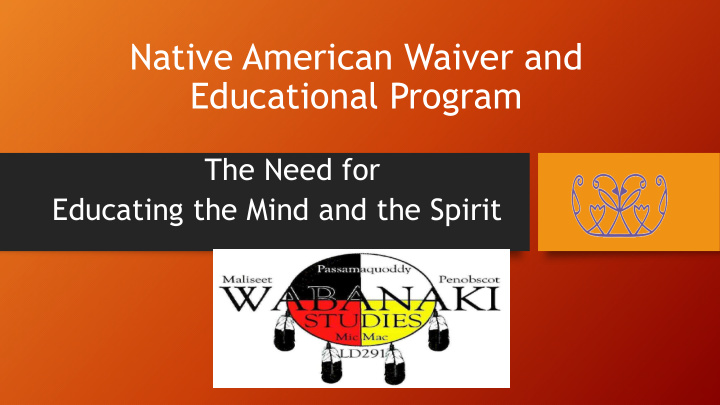



Native American Waiver and Educational Program The Need for Educating the Mind and the Spirit
Historical Perspective Traditional Education before Colonization
After Colonization: The Early Years of a Formal Education - Boarding Schools to Industrial Schools Forced Assimilation practices: “ Kill the Indian …Save the Man” Capt. Richard H. Pratt, created a loss of culture, language, spirituality, identity and created inter-generational trauma for years to come Carlisle Industrial School 1879
From 1879 until 1918, over 10,000 Native American children from 140 tribes attended Carlisle, including Wabanaki’s . By 1943, 2/3’s of Native peoples could not speak their own language. After 40 years only 158 graduated. Over a thousand Native children died .
Education in the hands of the Catholic Church on and off reservations Residential Schools in Canada and USA In 1928, a government official predicted Canada would end its "Indian problem" within two generations. Church- run, government-funded residential schools for native children were supposed to prepare/assimulate them for life in white society. But the aims of assimilation meant devastation for those who were subjected to physical, sexual, and emotional abuse. June 11, 2008 Canadian Prime Minister Harper formal apologizes to the First Nations of Canada
Native American Education Present Day Bureau of Indian Affairs placed education back in the hands of individual tribes in the 1940’s. After the Maine land claims in 1979-80, money began to support Native education Three reservation schools in Maine serving K-Grade 8 which were run by • the Catholic Church. NOW, more Native teachers are hired, less church presence. Reservation schools preserve cultural and boost academics. • Learning Centers established and summer supports system in place and in the last 5 years, summer language emersion classes are held Drop out rates increased when native students attended local High • Schools…. 65% (nationally) WHY? Isolation, feeling invisible, lack of cultural understanding, discrimination, racism, sport mascots, etc. all affect retention
Higher Education in Indian Country Today Inception : University of Maine System Board of Trustees – As a land grant university, the board of trustees voted to allow full scholarships to five students who were members of the Penobscot or Passamaquoddy tribes in 1934 . In 1971, the criteria were broadened to include all North American Indians thru the North American Tuition Waiver and Scholarship Program . Purpose- To encourage Maine’s Native Americans to participate in higher education. Waiver- covers all credit bearing classes and mandatory fees. The Educational program or the Room & board grant is based on a students financial need to cover living in the dorm. Early findings and educational barriers: Long term exposure to abuse, drugs, isolation, lack of confidence and extreme • poverty create an inability to learn • Native student unprepared for the academic course load with few parental role models in higher education Cultural practices unaccepted in non-native communities • Universities had no support services in place until 1996 • 1995 drop out rate at USM was 74%, Today about 10-15% •
Native American Waiver & Educational Program or NAWEP In 2012, the program was revised to make it more sustainable for the UMaine system. Tuition Waiver covers all credited courses and mandatory fees Students can earn Associates, Bachelors, Masters and Ph.d degree programs Room & Board Grant helps support students living in the dorms. The most neediest of students receive this grant. Students must be registered for 12 credits to live in the dorms. Financial Aid- all students must file a FAFSA and be eligible to receive it or students are not eligible for the NAWEP According to a 2005 report by the American Council on Education, the number of American Indian students attending college doubled from 1977 to 2002. In Maine, we have about 500 students in the UMaine system per year.
Who qualifies for the NAWEP? Tribal Members of Wabanaki Tribes and direct descendants Non-Wabanaki Tribal members Must be Tribal members no descendants All applications are approved or not, by John Bear Mitchell, the NAWEP System Coordinator at UMO
Creating a Successful Educational Experience Research Shows Educational Results Improved for Native students when : • Family Support- Families/member previously attend college offers great support, a family mentor can challenge and motivate, assist with academic skills, provide financial and education recourses, social skills and identity issues. W/O a family member with an educational background student success shows lover retention rates. • Cultural and Identify on College campus- through Native student groups /center incorporating Native lecturers/ guest speakers and programming containing a cultural component. Peer to peer mentoring programs are helpful. Common dorm area build a strong sense of community and spiritual base on campus • Institutional Support- caring faculty and staff (extended family) offers support emotional, cultural, and personally educationally. Learning Disabilities- improved resources to diagnose 51% of native students have learning • disabilities / ADD/HD issues most undiagnosed
Challenges for Native Students Education RELIGIOUS INTER-GENERATIONAL • • FINANCIAL TRAUMA • CULTURAL“OUTING” • SELF- MEDICADING • “ISM’S” AND • LEARNING DISABILITES And • STEREOTYPING MENTAL HEALTH ISSUES • CULTURAL ISOLATION
NATIVE AMERICAN PROGRAMMING AT USM Native American Awareness Month- November- Cultural • performances, cultural based workshops: from the Wabanaki Truth & Reconciliation trainings to basket making workshops. Earth Day- Honoring Mother Earth: bring Native Elders to speak • on Natural Resources, Petroglyphs, Tribal Historians Life & Traditions of the Red Man /Charlie Shay, • Talking Circle- Monthly newsletter • One Nation –USM’s Native Student Group •
Educating the Mind and the Spirit Kci woliwoni ("great thanks") Susan Lewey Hamilton Penobscot Tribal Member Coordinator, Multicultural Student Affairs & Coordinator, Native American Waiver and Educational Program susan.lewey.Hamilton@maine.edu
Recommend
More recommend